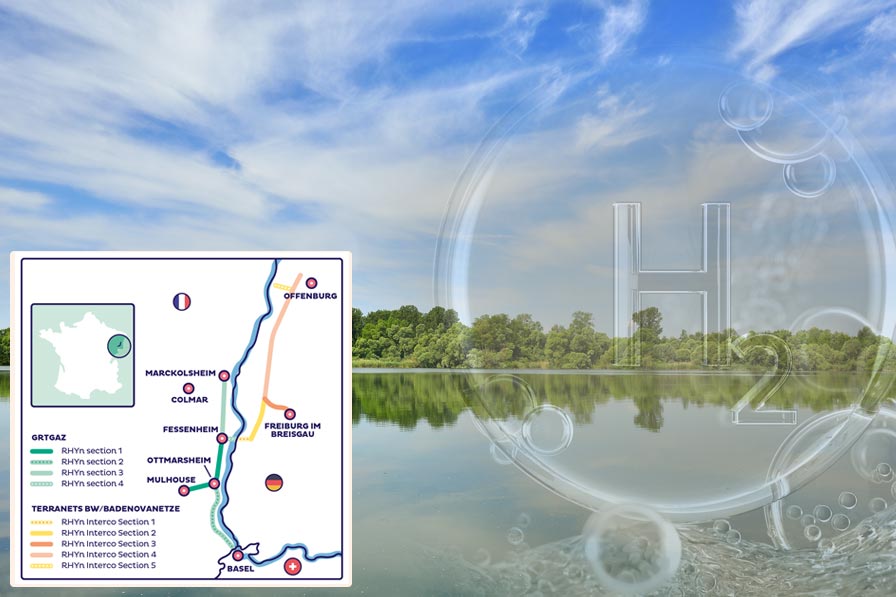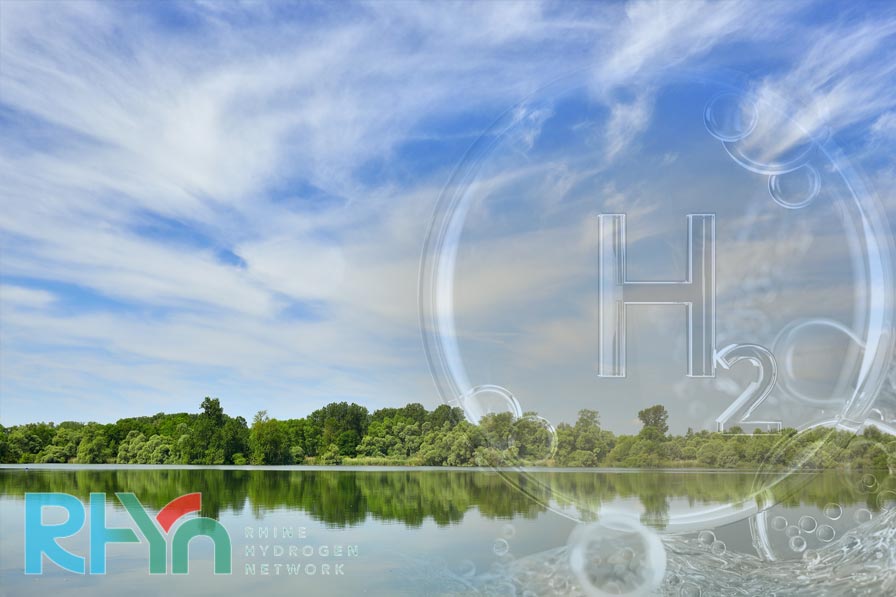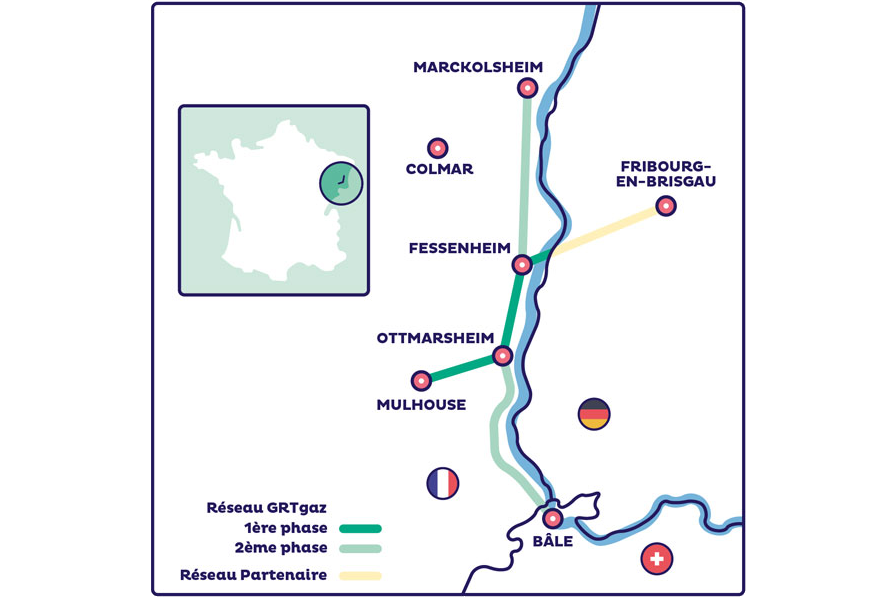Call for Expression of Interest from Upper Rhine market stakeholders: interview

The RHYn and RHYn Interco projects between France and Germany will be one of Europe’s first cross-border low-carbon hydrogen transmission networks, with commissioning planned for 2028. This is the inside story from the three network operators involved in the project: GRTgaz, terranets bw and badenovaNETZE.
On Monday 18 September, Calls for Expressions of Interest in the RHYn (Rhine HYdrogen Network) and RHYn Interco project were launched on both sides of the Rhine for a two-month period. Plans are in place for the interconnection of these low-carbon hydrogen transmission networks, which should be emerge by 2028 in France’s Grand-Est region and the Baden-Württemberg region of Germany. By 2035, the completed infrastructure will comprise a network spanning nearly 200 km, much of which will come from the conversion of natural gas pipelines to hydrogen (60 km on the French side and 90 km on the German side). The whole structure will supply major stakeholders, in particular industrial companies, by connecting them to the future European Hydrogen Backbone (EHB).
For the three major energy players involved in this large-scale project – TSOs GRTgaz on the French side and terranets bw on the German side, and the German DSO BadenovaNETZE – this represents a new chapter in the history of European cooperation. Jana Kavicka, H2 Business Developer at GRTgaz, Stephanie Seybold, from the Energy and Hydrogen Policy Department at terranets bw, and Leonie Meyer, Asset Management Officer and RHYn Interco Project Manager at badenovaNETZE GmbH, tell us about the project.
Why is the area that makes up your scope so promising for the development of a hydrogen transmission infrastructure?
Jana Kavicka (GRTgaz): “The aim is first and foremost to link the area’s industrial demand with future hydrogen production projects. On the French side, in the Grand-Est region, the route passes close to several major consumption sites, including a chemical platform. And it extends as far south as Basel-Mulhouse airport, which in the future will be the area’s largest hydrogen consumer for mobility. It’s a logical choice for GRTgaz to plan the project in an area with a strong industrial presence and significant decarbonisation needs, especially as we can propose an economically attractive infrastructure by converting part of our gas network.”
Stephanie Seybold (terranets bw): "We are trying to connect Baden-Württemberg to the European and national hydrogen infrastructure. BadenovaNETZE has a huge supply area, as well as being terranets bw’s largest customer in the Upper Rhine region. Demand in terranets bw’s downstream network is hence particularly relevant when it comes to developing a hydrogen infrastructure.”
Leonie Meyer (badenovaNETZE): “BadenovaNETZE has selected areas with a strong anticipated need for hydrogen supply. On the one hand, this choice is based on high current gas consumption; and, on the other, on the potential to integrate new sectors, such as mobility, for connection to the future hydrogen network. Our main aim is to show companies a way to achieve climate neutrality. For many of the region’s industries, the availability of hydrogen produced from renewable sources is a determining factor in their location."
What do you expect from the upcoming Call for Expressions of Interest (CEI)?
Jana Kavicka (GRTgaz): “GRTgaz develops its hydrogen pipelines based on customer requests. To move forward with the planning, we therefore need to confirm production and consumption forecasts and locate production sites. A CEI allows us to make the reliable assumptions we need to launch a feasibility study. Our aim here is to identify customers who are ready to commit to a genuine cooperation. For the infrastructure to be ready before 2030, we need to make big strides over the next two to three years.”
Leonie Meyer (badenovaNETZE): “We want to encourage more companies to submit an Expression of Interest for a connection to the hydrogen distribution network. We already have two partner companies in the University of Fribourg Medical Centre and Cerdia, a large producer of cellulose acetate. This is very important for our region, as it is a way for us to demonstrate the hydrogen consumption potential that exists here to potential producers. We would also like to raise awareness of the project among political institutions, and to show them that hydrogen attracts serious interest in the Upper Rhine region."
Stephanie Seybold (terranets bw): “We hope that the presentation of the RHYn and RHYn Interco projects will generate significant interest from German companies seeking to contribute to developing the first 100% hydrogen network in Baden-Württemberg, and to support the hydrogen production industry. If the region's hydrogen demand significantly exceeds potential production, we will need to rely on efficient import routes from abroad."
The cross-border nature of this project is its unique feature. What are you hoping for in terms of Franco-German synergy?
Stephanie Seybold (terranets bw): “France and Germany complement each other very well! While France has access to major sources of hydrogen and aims to export them, Germany will be dependent on imports in the future. The south of our country, in particular, has almost no production potential compared to the anticipated demand for hydrogen. The connection with France will create a direct link for Baden-Württemberg with major supply routes. We will be able import large quantities from the EHB corridor, Southwest Europe and North Africa."
Leonie Meyer (badenovaNETZE): "Cross-border cooperation is crucial for connecting Baden-Württemberg to the EHB and to French production projects. The RHYn Interco project is central to achieving this goal. In Germany, our production capacity is currently not large enough to supply hydrogen to consumers. Also, the global pipeline connections that would reach the Upper Rhine in Germany are not officially planned until 2040 at the earliest. The connection to France will allow the Upper Rhine region to connect much earlier to a network of long-distance gas pipelines (by 2028) and to the EHB (by 2030). This cooperation also offers potential hydrogen customers a greater choice of supply. The transition to a sustainable energy supply can only be made with our French partners."
Jana Kavicka (GRTgaz): “On the French side, the RHYn network has a capacity of 190,000 tonnes of hydrogen transported per year. This exceeds current local requirements. The network’s cross-border connection with RHYn Interco developed by terranets bw and badenovaNETZE will support German customers in meeting their decarbonisation goals. Its carbon balance will be all the more positive as it will be fully in line with European targets for 2030. Decarbonisation must be a collective, international effort!"
Can this type of cross-border project pave the way for a new European approach to developing the decarbonised energy infrastructures of the future?
Jana Kavicka (GRTgaz) : “The key to success, for sure, is cooperation between network operators. The example of the work done between GRTgaz and terranets bw also shows that even TSOs that had no interconnections until now can quickly join forces to build a very constructive collaboration."
Stephanie Seybold (terranets bw) : “Yes, a climate-neutral energy system, with a high proportion of volatile renewables, can only be created under international and pan-European conditions. The cross-border mutual support and cooperation required is a good reflection of the European idea."
Leonie Meyer (badenovaNETZE) : “Cross-border energy projects help optimise the use of resources. Some countries or regions have special energy needs that cannot be met directly in the present location. So it is vital that we look beyond national borders and consider energy supply from a European perspective. The RHYn Interco project is an excellent example of cross-border energy sector cooperation between Germany and France: a win-win situation for both parties. Without the connection with Alsace, companies in Baden-Württemberg would have a hazy understanding of hydrogen issues. But the future connection with Alsatian production sites gives these companies a solid vision of the transition to hydrogen."
To go further

Transporting hydrogen between France and Germany
